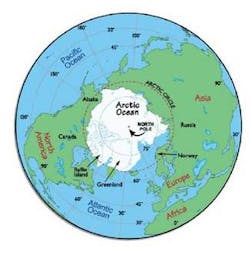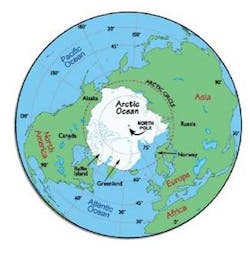The challenges facing arctic pipelines
Kim Mørk, DNV Segment for Arctic Operations and Technology
As oil and gas exploration and production move into more arctic areas, the need grows for an industry framework of fundamental design principles to deal with the extreme conditions.
According to the US Geological Survey, the offshore arctic holds as much as 25% of the world’s untapped reserves, with much of the reserves lying under seasonal or year-round sea ice. This means additional challenges for design, construction, and operation of offshore installations.
The international petroleum industry has limited experience with offshore exploration and development of oil and gas in arctic and cold climate areas. Technology and solutions that are proven in benign waters may have to be reassessed and modified for reliable use in arctic areas, and new industry guidelines are needed.
Several cold challenges
There are multiple definitions of the word “arctic” and the geographic extent that this term encompasses. In terms of oil and gas exploration, the word “arctic” should be interpreted as areas with prevailing cold climate conditions, i.e. where design and operations must consider extreme low temperature issues such as winterization, emergency response, cold flow assurance, ice conditions, and constrained operational envelopes.
Areas of interest for offshore arctic and sub-arctic development include the Barents Sea, the Russian Arctic, Alaskan Chukchi Sea, Beaufort Sea, the Canadian Arctic islands, offshore northeastern Canada, the Caspian Sea, and the Sea of Okhotsk offshore Sakhalin Island.
Each of these regions presents specific challenges that could require individual concept solutions and facilities. In any case, the solutions and facilities need to be both economical to build and safe to operate. In most ice-infested areas with moderate water depth, ice scour from ridges, stamukhi, or icebergs impact the design of any on-bottom infrastructure, including wellheads, trees, flowlines, umbilicals, and particularly pipelines. Ice gouging soil deformations including ice keel strength, ice/soil/pipe interaction, and protection concepts must be considered.
Additional considerations include arctic pipeline construction and installation issues for trenching and well intersection evaluations. Arctic pipeline operation, including leak detection, monitoring, and pipeline repair, are concerns. Flow assurance and long tieback distances also could add complexities.
All subsea pipelines in arctic conditions are not necessarily in an “extreme cold” environment. The minimum seabed temperature is often greater than 4° C (+25° F), which is not significantly different from all deep ocean temperatures. Offshore conditions are in contrast to the landfall area and onshore pipelines, which could experience temperatures to -40° C (-40° F) and lower.
Designing shore approaches requires specific consideration. This region is often much more problematic in sea ice areas than in other locations. The reasons can include near-shore environmental sensitivity, coastal regression, permafrost, and the deep burial required to prevent damage from ice gouging in shallow-water areas.
Strudel scour is scouring of the sea bed by water draining through strudel holes (“strudel” is German for “whirlpool”). This type of scouring is a localized seasonal phenomenon that occurs in the spring when freshwater in rivers and streams flows over the surface of frozen shore-fast ice. When the water makes its way under the ice, the resulting velocity and volume of water can be so great that a hole can be scoured into the seafloor, generating long free spans and exposing pipelines to high strains or fatigue due to vortex induced vibrations.
Most of the land surrounding the Arctic Ocean is underlain by permafrost. Permafrost is a significant issue for pipeline design because the subsidence of ice-rich permafrost due to heat input from a buried warm oil pipeline can overstress the line. This is a well-known issue for land pipelines and has been addressed in arctic areas by elevating the line above ground. Offshore experience is limited, and the extent, depth, permafrost properties, and the impact on the pipeline design need to be investigated.
Ice gouging
A specific challenge for subsea pipeline operation exists in ice infested shallow water where the pipeline is subjected to gouging ice keel features from ice ridges, stamukhi, and icebergs
The term “stamukha” originates from Russian ice classification and refers to sea ice that has broken and piled upward, or hummocked, because of wind or current.
While it is relatively simple in many cases to safely design the pipeline by prescribing a very deep burial depth, it can be extremely costly, impractical, or even impossible to accomplish in arctic areas because of complications with permafrost, trenching equipment, and confined operational envelope, among other factors.
A probabilistic approach is often proposed as a tool to achieve an economical minimum burial depth with acceptable risk. The challenge is to assess the prevailing uncertainty related to ice scour events, the interaction among the ice keel, the seabed, and the pipeline, and, eventually, the ultimate strain capacity in the pipeline. Many parameters such as gouge geometry, ice keel properties, soil properties, trench geometry, backfill properties, and pipeline stiffness, among others, contribute to make it a complex task. Complex integrated models are needed and pipe-soil interaction models for gouge events are just recently under developed by a number of parties with the objective to develop design procedures and qualify 3D geotechnical models.
Material issues
Historically, the majority of pipeline installations worldwide have used stress-based design principles. Traditional stress-based design applications pose limited challenges in terms of pipe material property requirements and weld procedure qualification requirements.
Offshore and onshore pipelines in arctic areas are exposed to challenging loading conditions such as permafrost, fault crossings, and ice scouring, which can impose localized high strain demands upon pipelines. These loads, in combination with very low temperatures, need to be considered when material and weld procedures are selected and qualified for strain-based design purposes.
In recent years, both onshore and offshore pipelines have been installed successfully that compensate for strain up to 4%. The goal is to use conventional linepipe steel, which is readily available from manufactures. To obtain steels that can sustain a large amount of strain, modifications often are necessary to achieve pipe with low yield-to-tensile ratio and high uniform elongation. This has resulted in dual-phase microstructure steels being applied to enhance the plastic deformation capability of linepipe for high-strain applications.
Installation and operation of oil and gas pipelines create stringent requirements in terms of controlling structural integrity, especially in arctic areas where the environment is especially vulnerable. The risk of fracture due to defects or cracks must be tightly controlled, and appropriate safety levels have to be assured. Therefore, the maximum allowable flaw sizes are often very small for arctic pipelines exposed to high strains. In some cases, flaw sizes can be of the same magnitude as the acceptance criteria for steel catenary risers.
Today, no fully validated ECA (engineering critical assessments) exist for strains in excess of 0.5%, where the effect of biaxial loading resulting from internal pressure is included. However, recent full-scale tests of pressurized pipes exposed to high strains have shown a degradation of the pipeline capacity with a factor of two compared to non-pressured pipe. The effects of biaxial stress on the crack driving force of pipeline girth weld flaws is an emerging issue and is the subject of current research.
The future
The growing focus on arctic oil and gas exploration has raised the need for new standards and industry practices. Material selection, qualification of materials for arctic pipelines, and design for pipelines against ice gouges are examples of areas that require more consideration. Although the first arctic pipelines were designed, installed, and operated more that 30 years ago, the design of pipelines subject to arctic conditions is evolving. Key drivers include the discovery of sufficient reserves to undertake costly development programs; along with innovation and research to address technology gaps in exploration, construction, operations, and maintenance.
For arctic pipelines, research and development are ongoing simultaneously with projects that are being executed in arctic areas. Meanwhile, R&D groups and experts will continue to discuss, develop, and refine detailed models. The industry needs a framework of fundamental design principles through which the R&D work can be developed and applied.
Recently, DNV initiated a joint industry project on arctic subsea pipelines with the objective of developing a recommended practice (RP_ to address the prevailing challenges. The approach of the RP is to present the first guidelines that draw together an overall current good practice for installation, operation, and maintenance of offshore pipelines in areas of extreme cold and ice.
About the author
Kim Mørk is the director, of DNV’s offshore pipelines segment for arctic operations and technology. Det Norske Veritas has developed codes and recommended practices for the oil and gas industry for more than 40 years.


